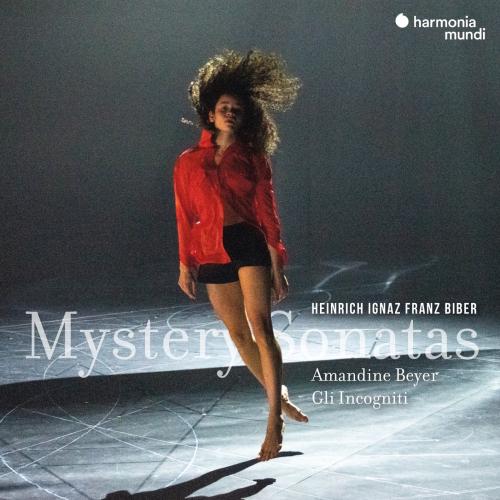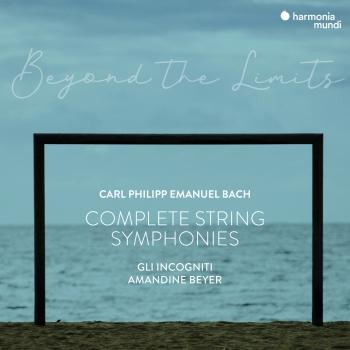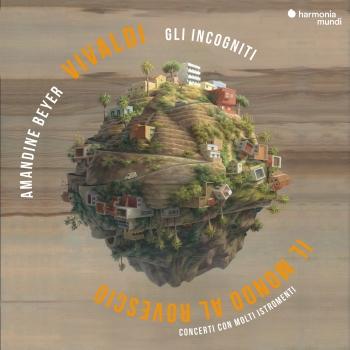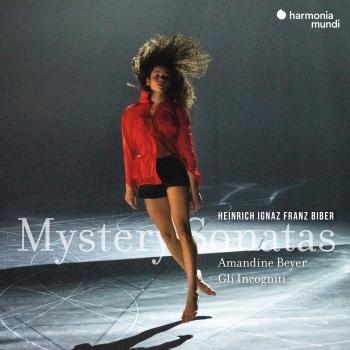
Biber: Mystery (Rosary) Sonatas Amandine Beyer & Gli incogniti
Album info
Album-Release:
2023
HRA-Release:
17.02.2023
Label: Harmonia Mundi
Genre: Classical
Subgenre: Chamber Music
Artist: Amandine Beyer & Gli incogniti
Composer: Heinrich Ignaz Franz von Biber (1644-1704)
Album including Album cover Booklet (PDF)
- Heinrich Ignaz Franz Biber (1644 - 1704): Mystery (Rosary) Sonata No. 1 in D Minor, The Annunciation:
- 1 Biber: Mystery (Rosary) Sonata No. 1 in D Minor, The Annunciation: I. Praeludium 02:01
- 2 Biber: Mystery (Rosary) Sonata No. 1 in D Minor, The Annunciation: II. Variatio - Aria allegro - Variatio - Adagio - [Variatio] 02:01
- 3 Biber: Mystery (Rosary) Sonata No. 1 in D Minor, The Annunciation: III. Finale 00:58
- Mystery (Rosary) Sonata No. 2 in A Major, The Visitation:
- 4 Biber: Mystery (Rosary) Sonata No. 2 in A Major, The Visitation: I. Sonata - Presto 01:29
- 5 Biber: Mystery (Rosary) Sonata No. 2 in A Major, The Visitation: II. Allaman[da] 02:00
- 6 Biber: Mystery (Rosary) Sonata No. 2 in A Major, The Visitation: III. Presto 00:40
- Mystery (Rosary) Sonata No. 3 in B Minor, The Nativity:
- 7 Biber: Mystery (Rosary) Sonata No. 3 in B Minor, The Nativity: I. Sonata - Presto - Adagio 01:11
- 8 Biber: Mystery (Rosary) Sonata No. 3 in B Minor, The Nativity: II. Courente - Double 02:22
- 9 Biber: Mystery (Rosary) Sonata No. 3 in B Minor, The Nativity: III. Adagio 01:27
- Mystery (Rosary) Sonata No. 4 in D Minor, The Presentation of Jesus in the Temple:
- 10 Biber: Mystery (Rosary) Sonata No. 4 in D Minor, The Presentation of Jesus in the Temple: Ciacona - Adagio 06:20
- Mystery (Rosary) Sonata No. 5 in A Major, The Finding of Jesus in the Temple:
- 11 Biber: Mystery (Rosary) Sonata No. 5 in A Major, The Finding of Jesus in the Temple: I. Praeludium - Presto 00:50
- 12 Biber: Mystery (Rosary) Sonata No. 5 in A Major, The Finding of Jesus in the Temple: II. Allaman[da] 01:20
- 13 Biber: Mystery (Rosary) Sonata No. 5 in A Major, The Finding of Jesus in the Temple: III. Guigue 01:09
- 14 Biber: Mystery (Rosary) Sonata No. 5 in A Major, The Finding of Jesus in the Temple: IV. Saraban[da] - Double 03:04
- Mystery (Rosary) Sonata No. 6 in C Minor, The Agony in the Garden:
- 15 Biber: Mystery (Rosary) Sonata No. 6 in C Minor, The Agony in the Garden: I. Lamento - Presto 02:52
- 16 Biber: Mystery (Rosary) Sonata No. 6 in C Minor, The Agony in the Garden: II. 02:07
- 17 Biber: Mystery (Rosary) Sonata No. 6 in C Minor, The Agony in the Garden: III. Adagio 00:40
- 18 Biber: Mystery (Rosary) Sonata No. 6 in C Minor, The Agony in the Garden: IV. 00:50
- Mystery (Rosary) Sonata No. 7 in F Major, The Scourging at the Pillar:
- 19 Biber: Mystery (Rosary) Sonata No. 7 in F Major, The Scourging at the Pillar: I. Allamanda - Variatio 02:58
- 20 Biber: Mystery (Rosary) Sonata No. 7 in F Major, The Scourging at the Pillar: II. Sarab[anda] - Variatio - [Variatio] - [Variatio] 04:16
- Mystery (Rosary) Sonata No. 8 in B-Flat Major, The Crowning with Thorns:
- 21 Biber: Mystery (Rosary) Sonata No. 8 in B-Flat Major, The Crowning with Thorns: I. Adagio - Presto - [Adagio] 01:55
- 22 Biber: Mystery (Rosary) Sonata No. 8 in B-Flat Major, The Crowning with Thorns: II. Guigue - Double I [Presto] - Double II 03:27
- Mystery (Rosary) Sonata No. 9 in A Minor, The Carrying of the Cross:
- 23 Biber: Mystery (Rosary) Sonata No. 9 in A Minor, The Carrying of the Cross: I. Sonata 01:50
- 24 Biber: Mystery (Rosary) Sonata No. 9 in A Minor, The Carrying of the Cross: II. Courente - Double - [Double] 02:58
- 25 Biber: Mystery (Rosary) Sonata No. 9 in A Minor, The Carrying of the Cross: III. Finale 01:19
- Mystery (Rosary) Sonata No. 10 in G Minor, The Crucifixion and Death of Jesus:
- 26 Biber: Mystery (Rosary) Sonata No. 10 in G Minor, The Crucifixion and Death of Jesus: I. Praeludium 01:08
- 27 Biber: Mystery (Rosary) Sonata No. 10 in G Minor, The Crucifixion and Death of Jesus: II. Aria - Variatio - [Variatio] 02:58
- 28 Biber: Mystery (Rosary) Sonata No. 10 in G Minor, The Crucifixion and Death of Jesus: III. Adagio - [Variatio] - [Variatio] 03:33
- Mystery (Rosary) Sonata No. 11 in G Major, The Resurrection:
- 29 Biber: Mystery (Rosary) Sonata No. 11 in G Major, The Resurrection: I. Sonata 02:27
- 30 Biber: Mystery (Rosary) Sonata No. 11 in G Major, The Resurrection: II. Surexit Christus hodie 04:13
- 31 Biber: Mystery (Rosary) Sonata No. 11 in G Major, The Resurrection: III. Adagio 01:08
- Mystery (Rosary) Sonata No. 12 in C Major, The Ascension:
- 32 Biber: Mystery (Rosary) Sonata No. 12 in C Major, The Ascension: I. Intrada 00:36
- 33 Biber: Mystery (Rosary) Sonata No. 12 in C Major, The Ascension: II. Aria Tubicinum 01:13
- 34 Biber: Mystery (Rosary) Sonata No. 12 in C Major, The Ascension: III. Allamanda 01:39
- 35 Biber: Mystery (Rosary) Sonata No. 12 in C Major, The Ascension: IV. Courente - Double 02:20
- Mystery (Rosary) Sonata No. 13 in D Minor, The Descent of the Holy Spirit:
- 36 Biber: Mystery (Rosary) Sonata No. 13 in D Minor, The Descent of the Holy Spirit: I. Sonata 03:02
- 37 Biber: Mystery (Rosary) Sonata No. 13 in D Minor, The Descent of the Holy Spirit: II. Gavott[a] 01:19
- 38 Biber: Mystery (Rosary) Sonata No. 13 in D Minor, The Descent of the Holy Spirit: III. Guigue 01:26
- 39 Biber: Mystery (Rosary) Sonata No. 13 in D Minor, The Descent of the Holy Spirit: IV. Sarabanda 01:35
- Mystery (Rosary) Sonata No. 14 in D Major, The Assumption of Mary into Heaven:
- 40 Biber: Mystery (Rosary) Sonata No. 14 in D Major, The Assumption of Mary into Heaven: I. [Praeludium] 01:57
- 41 Biber: Mystery (Rosary) Sonata No. 14 in D Major, The Assumption of Mary into Heaven: II. Aria - Guigue 05:29
- Mystery (Rosary) Sonata No. 15 in C Major, The Coronation of Mary as Queen of Heaven and Earth:
- 42 Biber: Mystery (Rosary) Sonata No. 15 in C Major, The Coronation of Mary as Queen of Heaven and Earth: I. Sonata 01:22
- 43 Biber: Mystery (Rosary) Sonata No. 15 in C Major, The Coronation of Mary as Queen of Heaven and Earth: II. Aria - [Variatio] - [Variatio] - [Variatio] 04:03
- 44 Biber: Mystery (Rosary) Sonata No. 15 in C Major, The Coronation of Mary as Queen of Heaven and Earth: III. Canzon[a] 01:21
- 45 Biber: Mystery (Rosary) Sonata No. 15 in C Major, The Coronation of Mary as Queen of Heaven and Earth: IV. Sarabanda - [Double] 02:47
- Mystery (Rosary) Sonata No. 16 in G Minor, The Guardian Angel:
- 46 Biber: Mystery (Rosary) Sonata No. 16 in G Minor, The Guardian Angel: Passacaglia 07:50
Info for Biber: Mystery (Rosary) Sonatas
Whether we call them ‘Mystery’ or ‘Rosary’ Sonatas, these fifteen pieces crowned by a sublime passacaglia for unaccompanied violin form one of the greatest violinistic masterpieces of the Baroque repertory. This version by Amandine Beyer and Gli Incogniti, derived from a dance project with the Rosas company, leads us into their magical universe through a novel prism: that of movement, to which these pieces are an infinite ode!
“A rose is a rose is a rose.” (Gertrude Stein)
Music and geometry have always been central to the work of Anne Teresa De Keersmaeker. In Mystery Sonatas / for Rosa, these interests form a bond through a symbol—the rose. With a long history of symbolism in art history and literature, the rose often represents secrecy and mystery. ‘Sub rosa’—Latin for ‘under the rose’—refers to ‘that which is not spoken’, but here we can consider this through the lens of ‘that which is danced’.
De Keersmaeker’s oeuvre is full of partnerships with musical compositions, and now she establishes another with the “Mystery” or “Rosary” sonatas of Heinrich Ignaz Franz Biber. Written around 1676, the Mystery Sonatas is a musical translation of the fifteen Sacred Mysteries of the life of the Virgin Mary. Composed with the intention of serving a religious practice, these sonatas assisted the recitation of the rosary beads. Just as the rosary is typically divided into three ‘decades’, Biber’s Mysteries are divided into three cycles: five joyful, five sorrowful, and five glorious sonatas.
Although the music is intrinsically filled with biblical narratives, it is simultaneously an invitation to dance. Found inside are musical dance forms such as gigues, allemandes, and courantes. This dancing nature combined with a cyclical and numerological approach, makes Biber’s work a terrain rich with inspiration for choreography. Similar to other works of De Keersmaeker, a ‘basic phrase’ provides a foundation, this time created through memories of the past. Circularity, repetition and petal-like patterns allow for transformations to unfold with the music.
In this choreography, roses are not simply at play because of their beauty, but because of their resistance—with every rose comes its thorns. The dancing body, as an individual or a community, becomes an act of resistance, while Biber’s music, rich in virtuosity and narrative, opens a door to it.
Intriguingly, this music enlists the technique ‘scordatura’, where the violin is tuned in a way that what is played according to the score is not what will be heard. This highly virtuosic technique is performed live by violinist Amandine Beyer, along with her ensemble Gli Incogniti. They share the stage with six dancers as they move chronically through the sonatas.
This work is dedicated to women of resistance—Rosa Bonheur, Rosa Luxemburg, Rosa Parks, Rosa Vergaelen, and Rosa, the 15-year-old climate activist who died in the Belgian floodings of 2021.
Gli Incogniti
Amandine Beyer, musical direction
Amandine Beyer
Since some years ago, Amandine Beyer is recognized as a reference in the interpretation of the baroque violin repertoire. Her recording of the Sonatas & Partitas by J. S. Bach in 2012, has been awarded the best international critics (Diapason d’or de l’année, Choc de Classica de l’année, Editor’s choice de Gramophone, Prix Academie Charles Cros, Excepcional de Scherzo....). The work in this masterpiece is being continued with the performance "Partita 2", choreographed and danced by Anne Theresa de Keersmaeker and Boris Charmatz.
She plays regularly in the most important halls and festivals worldwide (Théatre du Chatelet, Festival de Sablé, Innsbruck Festwochen, Konzerthaus de Viena...). She shares her time between between different music ensembles were she takes part off : les Cornets Noirs, the duos with Pierre Hantai, Kristian Bezuidenhout or Laurance Beyer and her own ensemble: Gli Incogniti (their CD's devoted to Vivaldi's Four Seasons and Corelli's Concerti Grossi have been welcomed by the international critic as new highlights in the performance of this repertoire).
Her other passion is teaching, giving lessons at the ESMAE of Porto (Portugal), as well as masterclasses worldwide (France, Taiwan, Brasil, Italy, Spain, USA, Canada). Since 2010 she teachs baroque violin at the Schola Cantorum Basiliensis in Switzerland.
Gli Incogniti
was founded in 2006 by a group of friends, brought together by the violinist Amandine Beyer. It is named after the Accademia degli Incogniti, an artistic and academic circle that was amongst the most active and libertarian of 17th century Venice. The spirit of this Accademia is indeed what drives the Incogniti today: a taste for the unknown in all its forms, for sound experimentation, research for new repertoire, for rediscovery of the “classics” and of lesser-known masterpieces.
The genuine pleasure they take in rehearsing and playing together meets their core ambition – to transmit a committed and coherent vision of the pieces they perform, connected to their combined sensitivities and personal preferences. The group now ranks among the top reference ensembles for historically informed performance, exploring a repertoire from baroque (Vivaldi, Bach, Pachelbel) to classic with Haydn, CPE Bach or even Mozart.
Booklet for Biber: Mystery (Rosary) Sonatas












